The Big Big Mega History Text History Post
3700 years in about that many words
This is Life as a Sacred Text, an expansive, loving, everybody-celebrating, nobody-diminished, justice-centered voyage into one of the world’s most ancient and holy books. More about the project here, and to subscribe, go here.🌱
Hi! So!
It occurs to me that something that could be useful for a lot of folks is a Big Picture Text/History overview, a 64,000 feet up weaving together of some of the Who? What? When? Where? of major moments in Jewish text. (The Why?—well, that’s another story, maybe.)
Needless to say, this is one post. This is going to be full of wild oversimplifications because that’s what happens when you try to cover like 3700 years in one post. So much will be glossed over or skipped, complexity will be painfully reduced to a sentence or two, if that. A lot won’t get mentioned. Sorry.
But the broad brush will nonetheless hopefully connect a few dots for some of y’all—and that’s hopefully worth something?
More nuance, as always, comes with further learning. (Reminder that a free resource page is here with some recommendations for starting places.) (Also reminder that sometimes bold is used for emphasis, but it often signals that there’s a link to more information.)
And reminder that you can support the time and research that goes into these posts by becoming a paid subscriber and spreading the word about Life is a Sacred Text. Share with a bunch of friends and earn free subscription months! Becoming a subscriber also gets you access to all the archives and weekly-ish groovy House of Study interactive posts.
OK! Let’s do this thing!
So let’s start with Torah—
- aka The Five Books of Moses
- aka The Pentateuch
- aka Genesis, Exodus, Leviticus, Numbers, Deuteronomy
- aka the most sacred of texts for Jews
It was EITHER: Given by God to Moses at Mt. Sinai
OR: Inspired by God and written down by people
OR: Developed in a few different contexts and then compiled together
Depending on, like, your theology and philosophy around these things.
Me, I lean towards the historical-critical approach (aka the third of the above options) but listen, it was a long time ago, and I think there are many ways in which that approach can work peaceably with the other two. l personally feel… agnostic.. about the question, “what really happened??” Like, it’s a fascinating question and I’ll always be eager to read about new evidence, but, in my opinion, it’s not the most important question. (What are we obligated to do now? Well.. that’s a question, imho.)
If the Sinai revelation did in fact happen (there is no evidence that it did happen— which is not, I will note, proof that it did not happen).. well traditional (Jewish) dating asserts that it took place ca. 1312 BCE. If it didn’t happen, parts of the Torah were probably composed in tandem with other parts of the Hebrew Bible.
Which—the Hebrew Bible! Aka the Tanakh! Which is an acronym! Torah, Neviim (Prophets), Ketuvim (Writings) = TNKh1 The Torah, as we’ve established, is the Fab Five + Prophets (Isaiah, Jeremiah, Hosea, etc) + Writings (Esther, Daniel, Psalms, Proverbs, etc) We also call it Hebrew Bible, that works. Please don’t call it the Old Testament.2
Let’s look at some maps!
(Let me be clear: the people now called Palestinians have also always existed on these lands. No matter what these maps do or don’t reflect.)3
1200 BCE - Exodus from Egypt (??)4 and the beginning of the Iron Age. You’ll notice two regions, there. Israel in the North, and Yehudah/Judah in the south. The red is the modern-day State of Israel’s current border—including the Occupied West Bank—and Gaza.
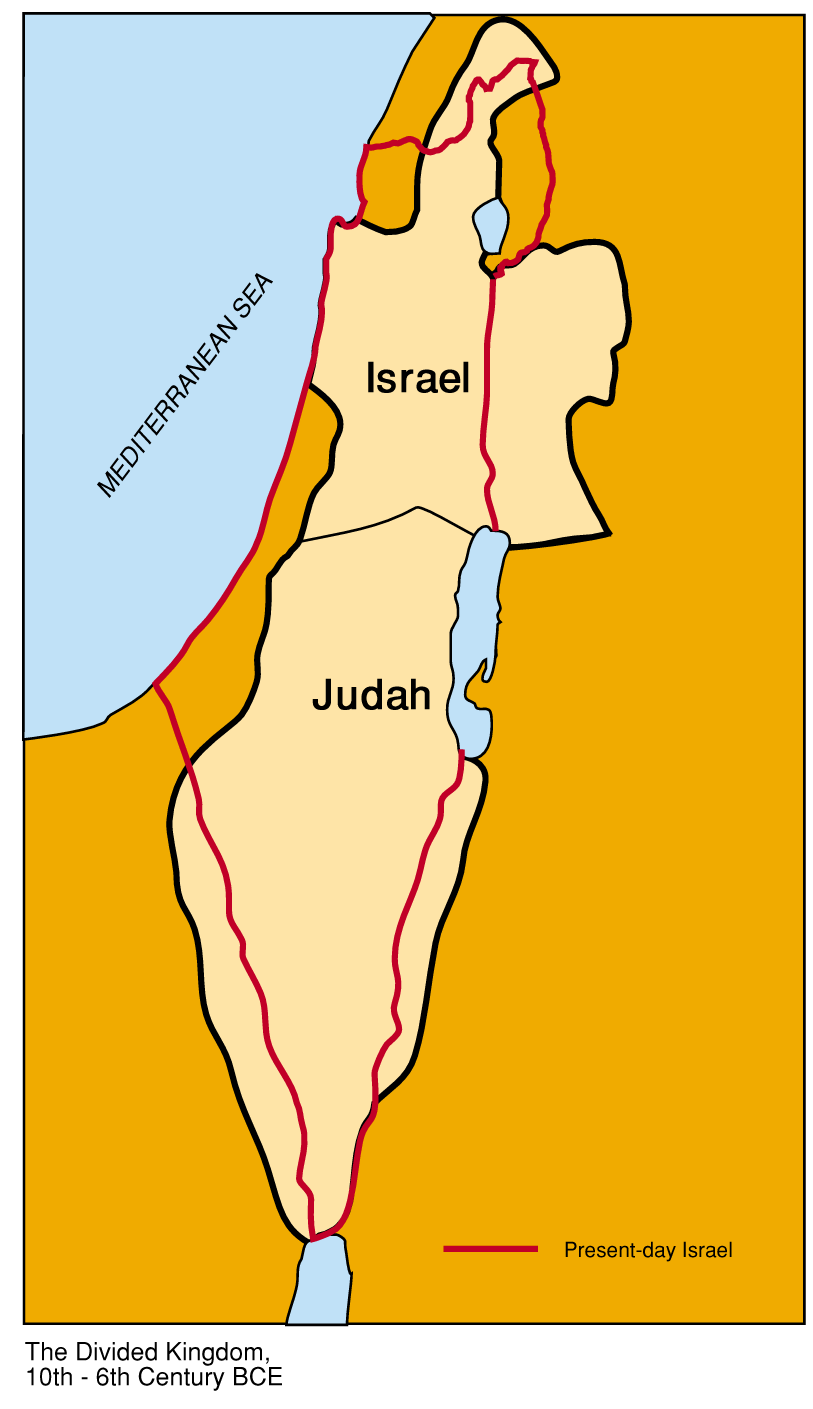
1000 BCE -(more or less) King David, according to biblical accounts, unites north and south kingdoms, creates the United Monarchy. Scholars debate the degree to which archeological evidence does or doesn’t support the biblical account. (Was there already a strong, centralized kingdom at this time? Was Jerusalem more of a minor settlement? Dunno.)
966 BCE - (According to the biblical narrative) The First Temple, built by King Solomon. (Some biblical scholars now think that it might have been built even earlier!) Upon his death, Solomon’s son fumbles on the United Monarchy, loses support of 10 of the tribes, that thing splits back in half like a baby on a royal sword.
721 BCE - The Assyrians come down from the North —from the land of what’s now Syria and/or Georgia, maybe Azerbaijan—and conquer the Kingdom of Israel (re: the map, above) and refugees from the north come down into Judah, possibly bringing some Torah traditions and other biblical stories with them (at least, some biblical scholars suggest it happened that way.)
701 BCE - The Assyrians conquer Judah, make it a vassal state.
605 BCE The Babylonians take over the Assyrian lease, take some young Judean nobility into Babylonian exile.
586 BCE- The Babylonians defeat a Judean uprising, and, using their tried and true “don’t try that again,” tactic, destroy First Temple and send a lot of Judeans into exile in Babylonia (what’s now Iraq) for 70 years.
538 BCE- The Persian Cyrus the Great lets the Judeans go home just a year after he captures Babylon.
516 BCE The Second Temple is built.
Now, I wanna pause here. A lot of very key Torah and biblical texts probably come from both the tragedy and trauma of exile—stories of yearning to be freed from enslavement, for example, and psalms of suffering—and the return to the Land of Israel. In fact, as I’ve mentioned here before, the debate about even whether or not to rebuild the Second Temple evidently appears all over Biblical and probably Torah texts. 🤯🤯🤯
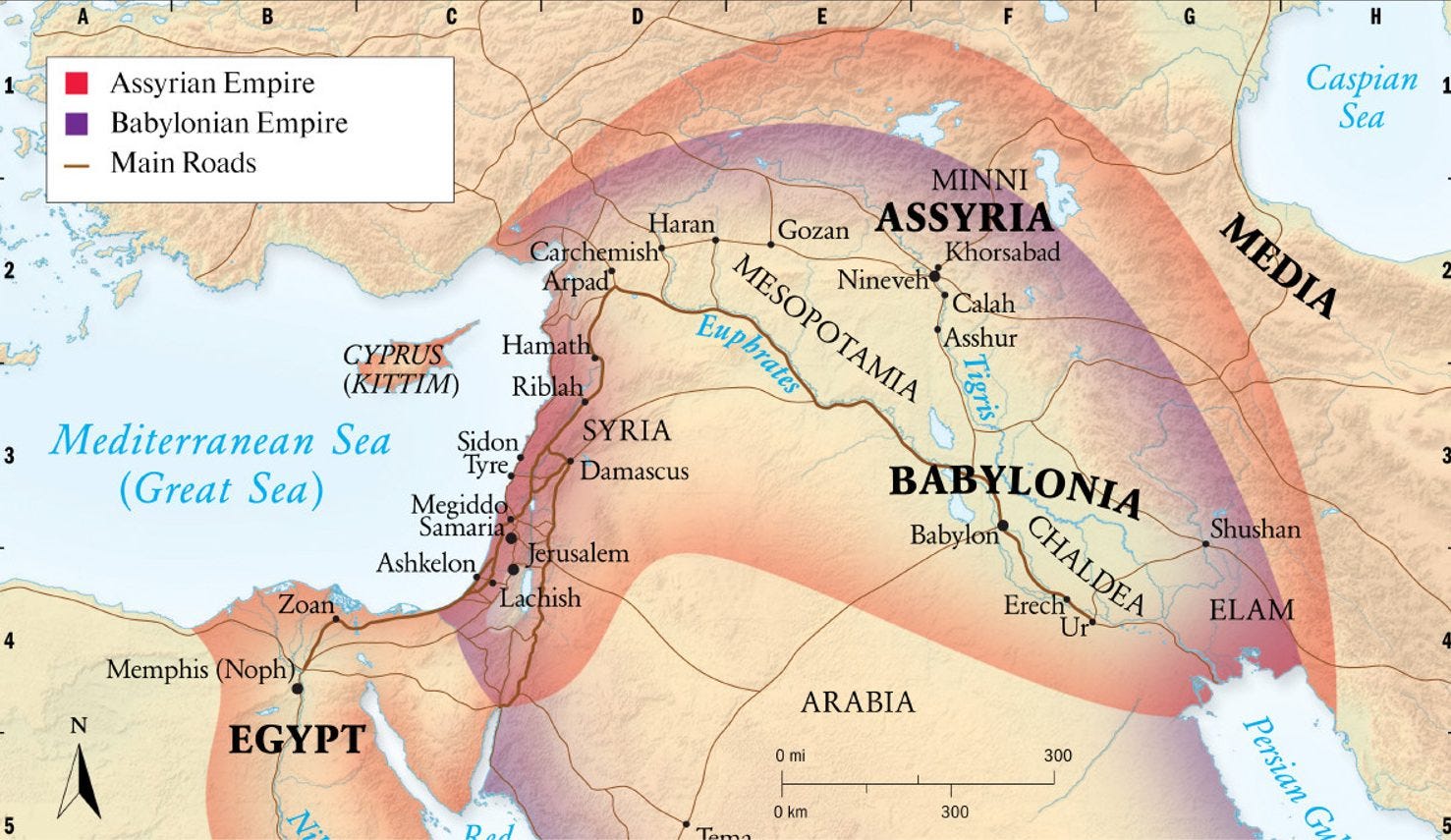
So much more to say about all of this!
But time ticks on!
332 BCE–Alexander the Great conquers the First Persian Empire, which includes our lil’ vassal state, Yehud/Judah. Hellenization stuff starts.
323 BCE Alex dies without naming a successor, we wind up with a new (Seleucid—Syrian empire) boss.
167–160 BCE Things under the Seleucid Antiochus IV have gotten gnarly enough that a tiny Maccabean revolt gathers big momentum and strikes hard. 🔨5 Happy Hanukah!
63 BCE Rome conquers Judea. Jeez, Judea’s like, can’t we get a second to just be in charge by ourselves, over here?
(NARRATOR: Not so much.)
(The nascent threads of Rabbinic Judaism are, or have been, developing, and begin to develop further in the later decades of the Second Temple.)
4 CE Judea comes under direct Roman administration. Instead of Judea doing what it wants and paying Rome (heavy) taxes, now they have to deal regularly with Roman bureaucrats and soldiers. Various resentments bloom—too many to get into here—but I don’t think anyone really enjoyed being under the Roman Empire, particularly.
66 CE Simmering tensions finally explode in the form of the Great Jewish Revolt — the Jews try to rise up against the Roman Empire, Maccabee-style. It… does not go as hoped.
70 CE Rome destroys the Second Temple as part of quashing/retaliating against the revolt.
Rabbinic Judaism’s development of practices and observance outside the Temple system gives Judaism anchors in the wake of this catastrophe—the Jewish religious system is not eviscerated.
Some people believe that the Mishnah, the Oral Torah, was given by God to Moses at Sinai and passed along since then. Historians tend to hold that it began to be developed robustly in the wake of the Temple’s destruction. Depends on your theology.
132-135 CE The Bar Kochba Revolt was an an all-in, last stand attempt to get the Romans out. It ends badly for the Jews. The Romans kill, enslave, and/or exile much of Judea. Jewish captives—estimated to be over 100,000 in number—-were reportedly sold for the price of one ration of food for a horse. And the whole area was “depopulated”— Jews throughout the region were sent into exile. Hadrian promulgated a series of religious edicts aimed at uprooting the Jewish nationalism in Judea, prohibiting Torah law and the Hebrew calendar and executing the great rabbinic leaders. (If you know about the martyrdom of the great Rabbis—the one that gets read sometimes at Yom Kippur—this was then.)6
This is traditionally marked as the beginning of galut. Exile from the Land of Israel. (Again—not everyone was kicked out—there were Jews that stayed, but it was nothing like what was before.)
150-200 CE Rabbi Yehuda HaNasi, the head of the Sanhedrin (high rabbinic court), realizing that things are a bit…chaotic.. codifies the Mishnah, which had been a loose oral collection until then. The Mishnah, and its cousins the Tosefta and assorted baraitot, are Rabbinic teachings from this era, from the Land of Israel.
200-500 CE Welp, Exile. So Jews set up shop BACK WHERE THEY WERE, more or less, durning the Babylonian exile. They create two main centers of learning in what’s now Iraq: Sura, and Pumbadita. Here, these later generations of Rabbis try to sort out what the Mishnah is doing—this is called the Gemara (but is often just called the Talmud.) Really, the Talmud = Mishnah + Gemara. It’s called the Babylonian Talmud because our guys have a nice strong sense of historical irony. They’re living under the Sassinian Empire, and sure, technically 700 years have passed, but jeez, it’s exile again, and they’re basically back in Babylon.
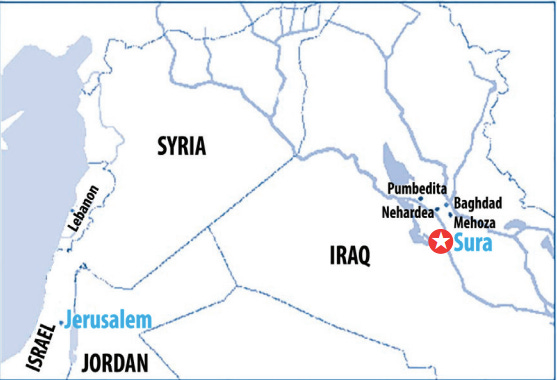
✨TEXT INTERLUDE✨
So to give you a sense of things, if the Torah says:
“God said to Moses:”Speak to the Israelite people and say…You shall keep Shabbat, for it is holy for you. …Six days may work be done, but on the seventh day there shall be a Shabbat of complete rest, holy to God.” (Exodus 31:12–15)
Keep Shabbat, dig. Cool. Butttt, OK, what do you.. Do? What do you .. not do?
So along comes the Mishnah to give us some principles:
The primary [categories of] labor [forbidden on Shabbat] are forty less one. 1. Sowing, plowing, reaping, binding sheaves, threshing, winnowing, selecting, grinding, sifting, kneading, and baking. 2. Shearing wool, bleaching, hackling, dyeing, spinning, stretching the threads, the making of two meshes, weaving two threads, dividing two threads, tying [knotting] and untying, sewing two stitches, and tearing in order to sew two stitches. 3. Capturing a deer, slaughtering, or flaying, or salting it, curing its hide, scraping it [of its hair], cutting it up, writing two letters, and erasing in order to write two letters [over the erasure]. 4. Building, pulling down, extinguishing, kindling, striking with a hammer, and carrying out from one domain to another. These are the forty primary labors less one. (Talmud Shabbat 7:2)
Got it? Here are the 39 categories of things you don’t do on Shabbat. The Mishnah’s list isn’t random, but rather that these are the labors for 1. Making bread 2. Making clothes 3. Writing sacred texts [that require animal parchment].7 4. Building.
The Gemara and later Jewish law will further itemize that, like, a lot of these “primary” categories generate “secondary” categories—like not plowing on Shabbat also means that one doesn’t dig, or irrigate to loosen the soil, or level a hill in order to prepare the ground for eventual plowing.
But still, lots of open questions.
Which is where so much of the Gemara comes in.
(Remember, Mishnah + Gemara = Talmud).
It doesn’t just do, like, “Oh, here are the secondary categories of prohibited labor on Shabbat,” in a nice, orderly list like we have above. Rather, you get a bunch of Rabbis arguing and telling stories and getting sidetracked and occasionally making weird jokes and then destroying each other’s arguments with better prooftexts and then throwing in some anecdote vaguely related to the subject at hand… but often trying to clarify an outrageous edge case so that you can know how to navigate the more boring everyday case. And then picture hundreds of years of those notes roughly arranged so arguments around the same mishnah are in kind of the same place, but it’s still pretty chaotic? Yeah.8
So here, the Gemara’s question is: “So, like, if I dragged a bench on Shabbat and I didn’t MEAN to be plowing, but it made a furrow! Did I sin? Or not?” Here’s a snippet of a much longer conversation, to give you a sense of how this goes.
the Head of the Kenesset of Batzra dragged a bench before Rabbi Yirmeya the Great on Shabbat. Rabbi Yirmeya said to him: In accordance with whose opinion do you permit yourself to drag a bench on Shabbat? Is it in accordance with the opinion of Rabbi Shimon? Say that Rabbi Shimon said his statement specifically with regard to large benches that are impossible to move from place to place in any other way, but in the case of small benches did he say that one is permitted to drag them? And this disagrees with the opinion of Ulla, as Ulla said: The dispute with regard to dragging is in the case of small benches; however, in the case of large benches, everyone agrees that one is permitted to drag them, as there is no other way to move them.
Rav Yosef raised an objection from what was taught in a baraita, Rabbi Shimon says: One may drag a bed, a chair, and a bench across the floor on Shabbat even though it creates a furrow, as long as he does not intend to create a furrow. (Babylonian Talmud Shabbat 29b)
You see how the Gemara is related to the Mishnah and Torah now? Broadly speaking? Agh! The broadest of brushes! It burns!
💥 Onwards into history!! 💥
500 CE-1000ish CE: The Geonim– The heads of the academies and law courts in Iraq, Egypt, Land of Israel, etc. who began the responsa tradition. A responsum (tshuvah) is when someone (an individual or a community) has a question (she’ila) about a matter of Jewish law, and then a scholar writes their answer/tshuvah about what they should do (basically: applying the principles of the Gemara to more specific cases!), and often those answers wind up being useful/applicable to lots of people, and important legal precedent.
1040-1105: Rashi- Troyes, France. Rabbi Shlomo Yitzchaki (RShY) - An important Torah and Talmud commentator, and a vintner, probably, to boot. 🍷
1096 The First Crusades’ Rhineland Massacres, a series of mass murders of Jews perpetrated by mobs of French and German Christians—knights and peasants, led by local leaders. Maybe largely disenfranchised locals. Jews were blamed for the crucifixion, and they were more immediately visible than the distant Muslims—why go all that way to kill infidels when there were non-Christians right here? About 10,000 Jews were slaughtered; entire communities.
Here’s Google Maps coming in to show you how close that was to Rashi’s home. Pretty close. This world-defining mass slaughter happened during his life. It impacted his commentary.
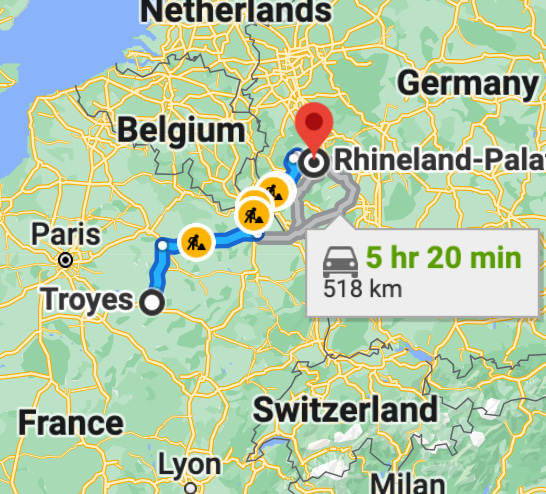
1100s-1400s: The Tosafists, across Europe, offered meta-commentary on the Talmud, aka often addressing what seem to be contradictions between tractates, rather than focusing on issues within the specific discussion itself.9 Some Tosafists were Rashi’s grandsons and students, yes, and yes, Rashi’s daughters were rumored to be learned and wear tefillin.
And note that these guys were doing deep Talmud learning as anti-Jewish oppression was heating up across Europe. That First Crusade was just a starter pogrom. There were exiles and pogroms a-go-go in this era. Plus discriminatory laws, the requirement that Jews wear distinctive yellow stars (yes, uh-huh), hats, or bands or the like, got disproportionately taxed, and all sorts of other fun stuff.
As Jewish Studies scholar Mika Ahuvia notes,
“Economists have correlated these expulsions with times of economic downturn, because of poor weather conditions, corruption, or plagues. Whenever things were going badly and leaders needed a scapegoat, it was useful for them to blame and expel Jews from their cities as a way of ‘taking action.’”
(This is a) still the case now with antisemitism and b) still the case now with xenophobia more broadly.)
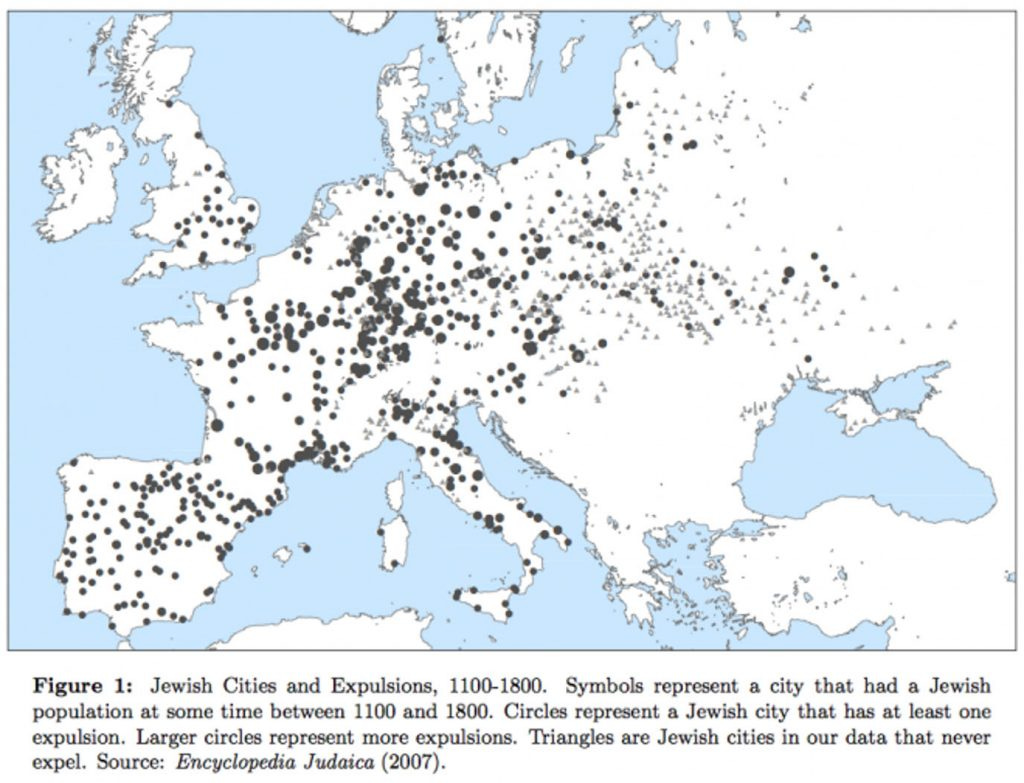
The Bomberg Talmud in 1523 gave us this iconic layout:
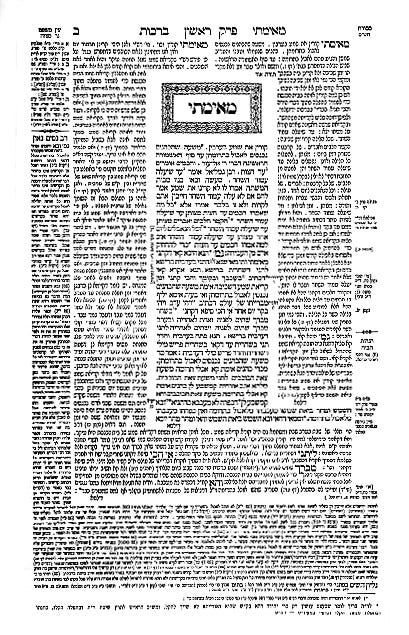
Thanks to Desiree for this excellent explainer of the Bomberg layout:
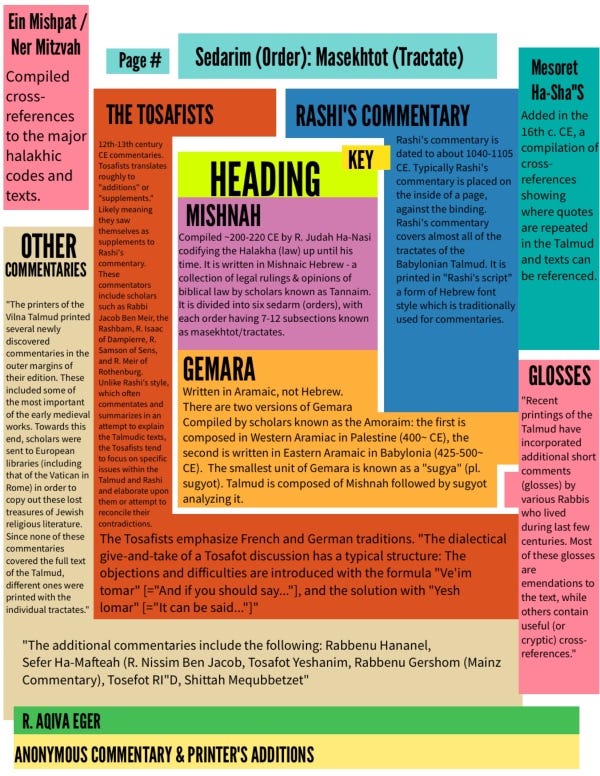
ELSEWHERE!
1000-1200s: There was a YUGE intellectual flowering in Spain So much to say about the cultural and spiritual interconnections of Muslims, Christians and Jews,10 especially Jews and Muslims in the southern part of what’s now Spain—but also a profound flowering of early Kabbalah11 in the north. We got Torah commentary, poetry (!), philosophy, so much good stuff.
Late 12th c: Maimonides - born in Cordoba, Spain, wound up in Egypt, Rabbi Moses Ben Maimon (RaMBM) - gave us the Mishneh Torah, and the philosophical work the Guide to the Perplexed.
The Mishneh Torah was a huge leap forward in the development of Jewish law. Instead of following the winding, twisty arguments of the Talmud, he’d just summarize for you, like, what to do, how to do it. EG:
Things that are permitted on Shabbat, but it is possible that while doing it, one might do forbidden labor and it is also possible that one might not: if one does not intend to do that particular labor, it is permitted. For example? One may drag a bed, a chair or a bench, etc. on Shabbat, so long as one does not intend to dig a ditch in the ground at the time that one drags them. (Mishneh Torah, Shabbat 1:5)
1492 King Ferdinand and Queen Isabella expel all the Jews from Spain. Sephardi Jews (Sephrad means Spain) wind up in North Africa, Italy, Turkey, Greece, the Netherlands, Syria, the Land of Israel, lotta other places.
(Mizrahi (“eastern”) generally refers to Jews who never left the Middle East—Iraq, Yemen, Israel etc., and/tho there are traditional Jewish communities just about everywhere in the globe—Central Asia, India, China, Ethiopia, Latin and South America, beyond.)12
1500s A massive flowering of Kabbalah happens in Tzfat/Safed, now the Land of Israel, then Ottoman Syria, almost entirely by the children of those expelled from Spain (or those expelled as children.) The Shulchan Aruch, “the set table”, which becomes the gold standard of Jewish law, is composed by mystic Yosef Karo, who was four when expelled.
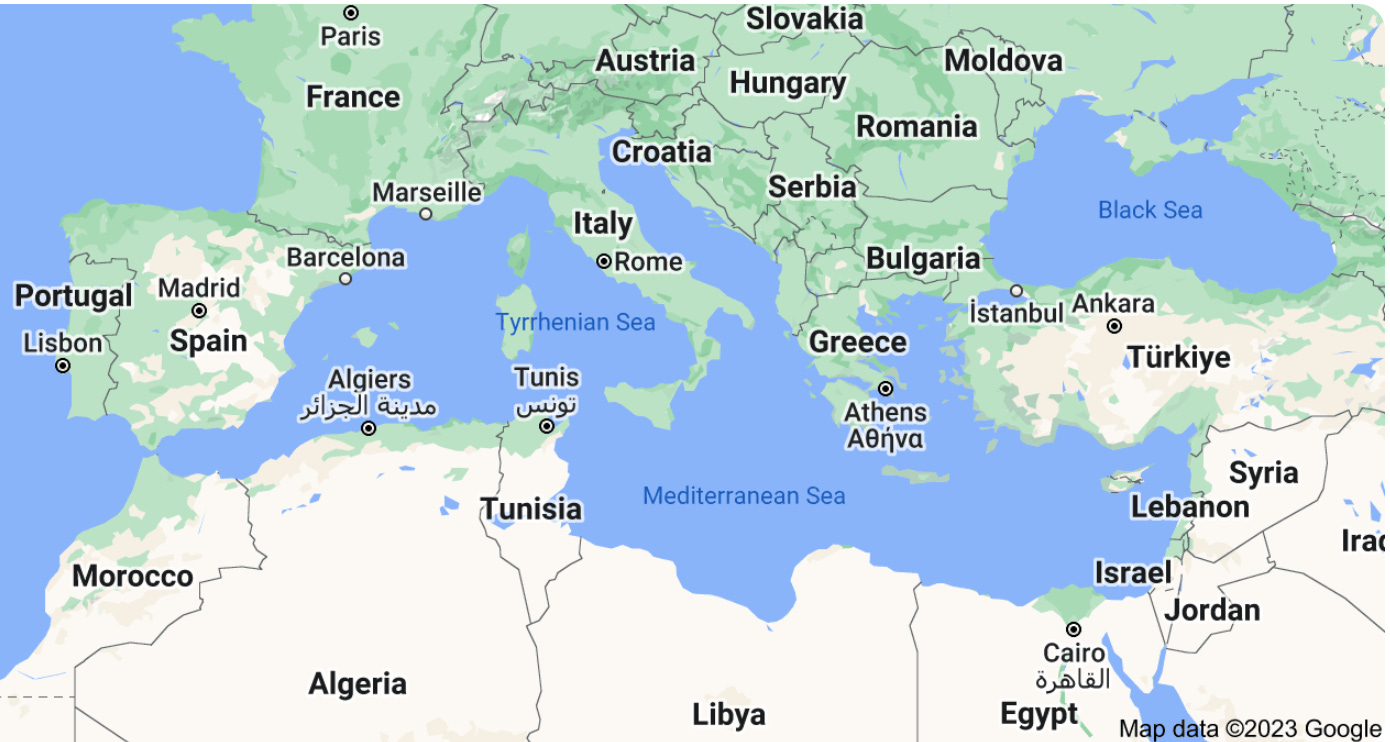
Sabbatai Zevi 1626-1676 False messiah! A Sephardi Kabbalist in Turkey. Convinced everyone he was Moshiach/the messiah, then (whoops) converted to Islam. The mass disillusionment impacted everything for centuries, probably.
The Baal Shem Tov aka Rabbi Yisroel ben Eliezer (1698-1760, Poland), mystic founder of Hasidut, a healer. He took some of the ideas from Kabbalah (until then, kind of an elite, esoteric stream of teaching), and some of his own innovations, taught them in a way that was more accessible to more people. A core teaching was about deveikut, cleaving/seeking union with God. He’s considered the founder of what we now call Hasidut (hesed = lovingkindness).
1700-1900s + beyond— Many of the Baal Shem Tov’s students and grand-students founded their own Hasidic dynasties with different teachings, emphases, but overall (broadly speaking) the idea is bringing that intention of clinging to God in not only prayer and mitzvot, but everything—with passion, music, stories, God-centeredness. Took fire throughout Eastern Europe in a myriad of different communities and schools, then came to the US + Israel.13
1770s-1881 Haskalah, the Jewish Enlightenment–gave us the concept of liberal, nationalist, pro-assimilation values in Germany & Prussia— with Jewish emancipation (beginning to treat Jews equally and giving them citizenship rights) in early-mid 19th c., more Jews saw themselves as Germans/Prussians, wanted to eg speak German, not Yiddish, interested in secular studies. Other movements towards Jewish freedom of thought emerged—eg the development of Modern Hebrew reflected the move towards a new modern Jewish collective.
1810 Considered the beginning of the Reform movement—a way to reconcile Judaism with secular thinking and contemporary life. A big move was to regard Jewish law as non-binding, as the individual Jew as more autonomous. More focus on ethics, the prophetic tradition.(“Orthodox” was originally a slur by the modernizers. Some argue what’s now Orthodox was how it always was, some say what’s now Orthodox is a reactive backlash to the Reform movement, and that the past used to be more fluid; some have other takes.)
1886 The Jewish Theological Seminary—still the Conservative Movement’s flagship seminary—is founded as a counterweight to Reform movement’s 1885 move making mitzvot more optional-ish.14
See, now I can either start holding forth on the complex strands of Zionism15, of the Russian Revolution, Jewish immigration to the US, the labor movements, feminism and other movements for liberation within Judaism, and so much more—or I can pause here. I think I’ll pause here.
SO! Thoughts? Learnings? What did you see or notice for having things all laid out this way? What’d I miss?
🌱 Like this? Get more:
Life is a Sacred Text is a reader-supported publication.
To get new posts and to support the labor that enables this project to exist, become a free or paid subscriber. Get long substantial essays like this every coupla weeks or so for free, and paid subscribersget even more text and provocation, on the reg.
The more friends you share this with the more months of free subscription you get!!!
And please know that if you want into the Thursday conversations but paying isn’t on the menu for you right now, we’ve got you. Just email lifeisasacredtext@gmail.com for a hookup.
And if you’d like to underwrite one of these donated subscriptions, you can do so here.
Please share this post:
💖 Sending a big pile of blessings and goodness your way. 💖
It doesn’t make sense in English but the Ketuvim letter is one of those letters that is pronounced like a hard c (“cat”) at the beginning of words and like a guttural ch (Baruch, Bach, or even Van Gogh) at the end of the word. This clears everything up, eh? (Or just trust me here). ↩
Just google “supersessionism,” OK? ↩
There have also always been Jews on these lands. Yes, even after Bar Kochba, though not to the same degree, obviously, for a while. And, as I just said, there have probably always been the people who are now called Palestinians on these lands. So what happens if we work towards solutions now that center human rights and human flourishing for everyone? Just a thought. ↩
If that reallly happened. Sorry. I know. Yeah. There’s no historical and archeological evidence that it did as described in Torah (though theories abound about the origins of this story). Some suggest that it may have originated during the Babylonian Exile as part of the yearning to be free from foreign oppression; others that the seeds of the story already existed and were further developed there. Barring dramatic new evidence coming to light, we may never know. ↩
Our boy Judah was given the nickname maqqəḇa, Aramaic for “hammer,” because he hit hard. ↩
If you don’t, I’ll do a thing on them at some point. It’s A Lot. ↩
Torah, Tefillin, Mezuzah, primarily, are the things on the level of the sacred that are written on animal parchment. ↩
If you study one double-sided folio of Talmud a day, you get through the whole thing in seven years. And it’s said that of approx. 5000 disagreements in the corpus, only 50 are resolved definitively on the page. Yeahhhh. ↩
That is—over in Tractate Brachot, the discussion seems to claim X, but here, they’re claiming Y, but of course there’s no true contradiction, because it’s all coherent somehow, so now here’s a long and squiggly logic journey to make it all somehow work together, pack some snacks… ↩
Though mind you, lotta Jews got burned and murdered in the “city of three cultures” (Toledo) so don’t always believe all the PR… ↩
WAYYYYY too complicated to get into here, friends. But it is a — not the only, but a — mystical stream of Judaism. Not the thing Madonna does. More on this some other time. God and the Big Bang by Daniel Matt (or anything else by him) is a good starting place, or the Thirteen-Petaled Rose by R. Adin Steinsaltz. (z’l) ↩
I acknowledge the eurocentricity of the last half of this post, am trying to quickly draw people to the themes that impact US Judaism, which are Euro AF. Should go looking for guest posts of folks who can fill in blanks re: what’s happening in parts of the world I can’t cover with as much facility. ↩
BROAD BRUSH, Yidden. BROAD BRUSH. ↩
The Reform thing was called the Pittsburgh Platform, was a BFD. Conservative was conserving religiously, has nothing to do with politics. “Tradition and change” is the ever-present slogan. ↩
Think what you want about the Israeli government’s occupation of Palestinian land and lives, including how Nakba went down (I sure do) but the basic impetus for Zionism was a) in an Enlightenment age of nationalism, the French had France, the Germans had Germany, and the Jews didn’t have a country of their own, but rather got kicked from country to country based on the whims of the ruler at the time and it was not great b) Plus pogroms! The whole concept rested on the idea that only sovereignty could free Jews from persecution. Yes, again, we might have what to say about what was missing from the logic then and/or what things look like now, but that was the concept in the late 19th c. ↩

